The year before I started my prefabricated metal-plate connected roof truss career with Coeur d’Alene Truss in 1977, they had provided hundreds of 60 foot span trusses for a cabinet manufacturing plant. The building was being erected by an experienced contractor who had an excellent reputation for quality. For my future employer, this was their largest sale, and he proudly went out to take photos of all of the trusses, set in place.
The next morning, the trusses were on the ground, nothing but a pile of kindling! Luckily (for the truss company anyhow) the photos taken showed the truss bracing had been installed only in one direction and a puff of wind caused them to topple in the opposite direction.
As a truss manufacturer, I’ve built wide span trusses, up to 100 foot span, and as a builder installed trusses up to 92 foot.
 High grade msr (machine stress rated) and mel (machine evaluated lumber) have allowed for metal-plate connected trusses to practically and affordably be designed and fabricated for spans of 100 feet and wider. The pole building industry has taken advantage of these spanning capabilities to provide wider clearspans for commercial, industrial and manufacturing industries, as well as the traditional agricultural market.
High grade msr (machine stress rated) and mel (machine evaluated lumber) have allowed for metal-plate connected trusses to practically and affordably be designed and fabricated for spans of 100 feet and wider. The pole building industry has taken advantage of these spanning capabilities to provide wider clearspans for commercial, industrial and manufacturing industries, as well as the traditional agricultural market.
For those who design, fabricate and build with wide span trusses, code and regulation changes have occurred effective with the 2009 edition of the building codes.
For the pole building industry, the involvement of a registered design professional (RDP – engineer or architect) who can design correctly and knows what they are doing, becomes critical.
The focus on wide span trusses is due to the liability, as problems tend to grow exponentially with the size of the truss. Everything tends to become more challenging beginning with the fabrication, handling, loading and transportation from the truss manufacturer.
When I had my truss plant in Spokane, we had the opportunity to do a large project (a hockey rink) with 114 foot span trusses. We could build them, but we could not figure out how to get them around one of the corners between our location and the proposed jobsite!
With wide span trusses, installation and bracing requirements become critical. They maximize the capabilities of the installation contractor and of the components of the truss.
As the forces which must be carried by a truss (or any beam) are a product of the square of the span, what must be carried by an 80 foot span is four times what a 40 span would carry! This makes for much heavier trusses and increases the impact in the event of an accident.
The Hansen Pole Buildings Construction Guide includes information on proper truss installation. There are other sources on current codes and regulations, including Building Component Safety Information Guide to Good Practice for Handling, Installing, Restraining and Bracing of Metal Plate Connected Wood Trusses, produced by the Structural Building Components Association and the Truss Plate Institute, and Truss Technology in Buildings by the Wood Truss Council of America, Inc.
You can find it here:
https://support.sbcindustry.com/docs/06_BCSI_booklet_FINAL.pdf
My personal pole building engineering mentors, wood engineers Frank E. Woeste, PhD PE, and Donald A. Bender, PhD PE, have authored articles which urge RDPs who specify wide span wood trusses for post-frame buildings to take special note of recent changes in the 2009 International Building Code and the ANSI/TPI 1-2007 truss design standard.
Owners of a project with metal-plate-connected wood trusses spanning 60 feet and greater are now required to engage an RDP to design and inspect both temporary and permanent bracing for trusses (See International Building Code Sections 2303.4.1.3, 1704.6.2, and 1704






